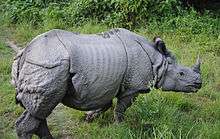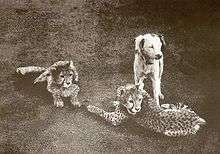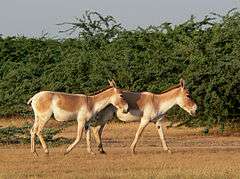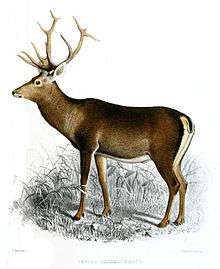Wildlife of Pakistan
The wildlife of Pakistan comprises a diverse flora and fauna in a wide range of habitats from sea level to high elevation areas in the mountains, including 177 mammal and 660 bird species.[1] This diverse composition of the country's fauna is associated with its location in the transitional zone between two major zoogeographical regions, the Palearctic, and the Oriental.[2]
| Part of a series on |
| Wildlife of Pakistan |
|---|
 |
|
Biodiversity Fauna and Flora
|
|
Conservation Protected areas
|
|
Organizations National
Ministry of Environment (Pakistan) · Pakistan Environmental Protection Agency · Dhodial Pheasantry · Zoological Survey Department of Pakistan · Sindh Wildlife Department · Punjab Wildlife Department · Khyber Pakhtukhwa Wildlife Department · Baluchistan Wildlife Department · Gilgit Baltistan Wildlife Department · Himalayan Wildlife Foundation · National Institute of Oceanography (Pakistan) International
|
|
Related topics Ecoregions · Forestry · Fishing Agriculture · Tourism Botanical and Zoological gardens Environmental issues |
Habitats
Northern highlands and plains
The northern highlands include lower elevation areas of Potohar and Azad Jammu and Kashmir regions and higher elevation areas embracing the foothills of Himalayan, Karakorum and Hindukush mountain ranges. These areas provide an excellent habitat for wildlife in the form of alpine grazing lands, sub-alpine scrub and temperate forests. The areas are difficult for human beings to access, hence, most wildlife is present in reasonable numbers though some are endangered for other reasons. The northern highlands of Pakistan are covered with conifer and scrub forests, which have been reduced to scanty growth in most places. This biome is defined as northwestern Himalayan alpine shrub and meadows.
Some of the wildlife species found in northern mountainous areas and Pothohar Plateau include the bharal, Eurasian lynx, Himalayan goral, Marco Polo sheep, marmot (in Deosai National Park) and yellow-throated marten and birds species of chukar partridge, Eurasian eagle-owl, Himalayan monal and Himalayan snowcock and amphibian species of Himalayan toad and Muree Hills frog.
Threatened species include the snow leopard, Himalayan brown bear, Indian wolf, Rhesus macaque, Markhor, Siberian ibex, white-bellied musk deer.[3][4][5][6][7][8][9][10][11]
Bird species present are cheer pheasant, peregrine falcon and western tragopan.[12]
 Snow leopard, national predator of Pakistan
Snow leopard, national predator of Pakistan Himalyan Brown Bears
Himalyan Brown Bears.jpg) Markhor
Markhor_female.jpg) Rhesus macaque
Rhesus macaque Chukar, the national bird of Pakistan
Chukar, the national bird of Pakistan
Indus plains and deserts of Sindh
River Indus and its numerous eastern tributaries of Chenab, Ravi, Sutlej, Jhelum, Beas are spread across most of Punjab. The plain of river Indus continues towards and occupy most of western Sindh. The plains have many fluvial landforms (including bars, flood plains, levees, meanders and ox-bows) that support various natural biomes including tropical and subtropical dry and moist broadleaf forestry as well as tropical and xeric shrublands (deserts of Thal and Cholistan in Punjab, Nara and Thar in Sindh). The banks and stream beds of the river system also support riparian woodlands that exhibit the tree species of kikar, mulberry and sheesham. The reed beds and tamarisk bushes along the rivers are also present. Such geographical landforms accompanied by an excellent system of monsoon climate provides an excellent ground for diversity of flora and fauna species. However, the plains are equally appealing to humans for agricultural goals and development of civilization. Vast Indus flood plains have been cleared of natural vegetation to grow crops. This has caused only a few species to become endangered.
Some of the non-threatened mammal species includes the nilgai, red fox and wild boar, bird species of Alexandrine parakeet, barn owl, black kite, myna, hoopoe, Indian peafowl, Indian leopard, red-vented bulbul, rock pigeon, shelduck and shikra, reptile species of Indian cobra, Indian star tortoise, Sindh krait and yellow monitor and amphibian species of Indus Valley bullfrog and Indus Valley toad. Some of the threatened mammal species include the, axis deer, blackbuck (in captivity; extinct in wild), hog deer, dholes, Indian pangolin, Punjab urial and Sindh ibex, bird species of white-backed vulture and reptile species of black pond turtle and gharial. Grey partridge is one of the few birds that can be found in the Cholistan desert. The Tharparkar desert supports a fair population of the Chinkara. Wild boar numbers have increased because of the immunity they enjoy in a Muslim society that forbids its consumption by humans.[13]
Mugger crocodiles inhabit the Deh Akro-II Desert Wetland Complex, Nara Desert Wildlife Sanctuary, Chotiari Reservoir and Haleji Lake.[14][15][16]
 Red fox
Red fox.jpg) Mugger crocodile
Mugger crocodile Blackbuck antepole
Blackbuck antepole_male.jpg) Nilgai
Nilgai
 Peafowl
Peafowl
Western highlands, plains and deserts

Western region of Pakistan, most of which is enveloped in Balochistan province, has a complex geography. In mountainous highlands, habitat varies from conifer forests of deodar in Waziristan and juniper in Ziarat. Numerous mountain ranges surround the huge lowland plains of Balochistani Plateau, through which a rather intricate meshwork of seasonal rivers and salt pans is spread. Deserts are also present, showing xeric shrubland vegetation in the region. Date palms and ephedra are common flora varieties in the desert.
The Balochistan leopard has been described from this region.[17] Some of the mammal species include the caracal, Balochistan dormouse, Blanford's fox, dromedary camel, goitered gazelle, Indian crested porcupine, long-eared hedgehog, markhor, ratel, and striped hyena, bird species of bearded vulture, houbara bustard and merlin, reptile species of leopard gecko and saw-scaled viper and amphibian species of Balochistan toad.
Wetlands, coastal regions and marine life

There are a number of protected wetlands (under Ramsar Convention) in Pakistan. These include Tanda dam and Thanedar Wala in Khyber Pakhtunkhwa, Chashma barrage, Taunsa barrage and Uchhali complex in Punjab, Haleji lake, Hub dam and Kinjhar lake in Sindh, Miani Hor in Balochistan. The wetlands are a habitat for migratory birds such as dalmatian pelicans and demoiselle crane as well as predatory species of osprey, common kingfisher, fishing cat and leopard cat near the coast line. Chashma and Taunsa Barrage Dolphin Sanctuary protects the threatened species of Indus river dolphins which tend to live in freshwater.
The coastline of Pakistan is 1,050 km long and consists of a variety of habitat types, supporting a wide range of animals, of which over 1000 are fish species in the reefs of its continental shelf. The east half of the coast of Pakistan is located in the south of Sindh province which features Indus River Delta and coast of Great Rann of Kutch. The largest saltwater wetland in Pakistan is the Indus River Delta. Unlike many other river deltas, it consists of clay soil and is very swampy. West coast of Great Rann of Kutch, east to the Indus River Delta and below Tharparkar desert, is one of the few places where greater flamingos come to breed. It is also a habitat for endangered species of lesser florican. Unlike Indus River Delta, this part of the coast is not as swampy and exhibits shrubland vegetation of rather dry thorny shrubs as well as marsh grasses of Apluda and Cenchrus.
The vegetation of Indus River Delta is mainly represented by various mangrove species and bamboo species. The Indus River Delta-Arabian Sea mangroves is a focused ecoregion of WWF. Nearly 95% of the mangroves located in the Indus River Delta are of the species Avicennia marina. Very small patches of Ceriops roxburghiana and Aegicerias corniculata are found. These provide nesting grounds for common snakehead, giant snakehead, Indus baril and many species of catfish like rita. The hilsa swims up from the Arabian Sea to spawn in freshwater. Species that are important to people as food, such as the golden mahseer and large freshwater shrimp (Macrobrachium species), are part of the abundant aquatic life.
The west half of the Pakistan coast is in the south of Balochistan province. It is also called the Makran coast and exhibits protected sites such as Astola Island and Hingol National Park. The three major mangrove plantations of Balochistan coast are Miani Hor, Kalmat Khor and Gwatar Bay. Miani Hor is a swampy lagoon on the coast in the Lasbela district where the climate is very arid. The sources of fresh water for Miani Hor are the seasonal river of Porali. The nearest river to the other lagoon, Kalmat Khor, is the Basol River. Gawatar, the third site, is an open bay with a mouth almost as wide as its length. Its freshwater source is the Dasht River, the largest seasonal river of Baluchistan. All three bays support mainly A. marina species of mangrove. Pakistan also plans to rehabilitate mangrove-degraded areas at Sonmiani and Jiwani in Balochistan.
Along the shores of Astola and Ormara beaches of Balochistan and Hawk'e Bay and Sandspit beaches of Sindh are nesting sites for five endangered species of sea turtles: green sea, loggerhead, hawksbill, olive ridley and leatherback. Sea snakes such as yellow-bellied sea snake are also found in the pelagic zone of the sea. The wetlands of Pakistan are also a home to the mugger crocodile who prefer freshwater habitat.
Extinct
Regionally extinct species in Pakistan include:
- Indian rhinoceros (since the 17th century)[18]
- Asian elephant[19]
- Asiatic lion[20][21]
- Asiatic cheetah[22]
- Bengal tiger[23]
- Barasingha[24]
- Indian wild ass (since the installation of a fenced border at Sir Creek between India and Pakistan).[25]
- Kashmir stag (possibly extinct).[26]
 An Indian rhinoceros in Bardia National Park, Nepal
An Indian rhinoceros in Bardia National Park, Nepal Prime Indian elephant habitat consists of forested areas
Prime Indian elephant habitat consists of forested areas Asiatic lion in India's Gir Forest
Asiatic lion in India's Gir Forest Asiatic cheetah cubs with a dog in Dharwar, British India, 1897
Asiatic cheetah cubs with a dog in Dharwar, British India, 1897 Bengal tiger in Mangalore, India
Bengal tiger in Mangalore, India A Southern barasingha stag in Kanha National Park, India
A Southern barasingha stag in Kanha National Park, India Indian wild asses in Little Rann of Kutch
Indian wild asses in Little Rann of Kutch Kashmir stag
Kashmir stag
See also
- List of mammals of Pakistan
- Wildflowers of Pakistan
- Invertebrates of Pakistan
- Non-marine molluscs of Pakistan
- Butterflies of Pakistan
- Spiders of Pakistan
- Vertebrates of Pakistan
- Fishes of Pakistan
- Amphibians of Pakistan
- Reptiles of Pakistan
- Birds of Pakistan (Birds of Islamabad)
- Mammals of Pakistan
References
- Roberts, T. (1977). Mammals of Pakistan. London and Tonbridge: Ernest Benn Limited.
- Shah, M. and Baig, K.J. (1999). "Threatened Species Listing in Pakistan: status, issues and prospects". In IUCN (ed.). Using IUCN Red List Criteria at National Level: A Regional Consultative Workshop for South and Southeast Asia, Sri Lanka. IUCN Regional Biodiversity Program, Asia. pp. 70–81.CS1 maint: multiple names: authors list (link)
- Anwar, M.B., Jackson, R., Nadeem, M.S., Janečka, J.E., Hussain, S., Beg, M.A., Muhammad, G. and Qayyum, M. (2011). "Food habits of the snow leopard Panthera uncia (Schreber, 1775) in Baltistan, Northern Pakistan". European Journal of Wildlife Research. 57 (57(5)): 1077–1083. doi:10.1007/s10344-011-0521-2.CS1 maint: uses authors parameter (link)
- Kabir, M., Ghoddousi, A., Awan, M.S. and Awan, M.N. (2014). "Assessment of human–leopard conflict in Machiara National Park, Azad Jammu and Kashmir, Pakistan". European Journal of Wildlife Research. 60 (60(2)): 291–296. doi:10.1007/s10344-013-0782-z.CS1 maint: uses authors parameter (link)
- Bellemain, E., Nawaz, M.A., Valentini, A., Swenson, J.E. and Taberlet, P. (2007). "Genetic tracking of the brown bear in northern Pakistan and implications for conservation". Biological Conservation. 134 (134(4)): 537–547. doi:10.1016/j.biocon.2006.09.004.CS1 maint: uses authors parameter (link)
- Qureshi, R., Khan, W.A., Bhatti, G.R., Khan, B.A.B.A.R., Iqbal, S., Ahmad, M.S., Abid, M. and Yaqub, A. (2011). "First report on the biodiversity of Khunjerab National Park, Pakistan". Pakistan Journal of Botany (43(2)): 849–861.CS1 maint: multiple names: authors list (link)
- Minhas, R.A., Ahmed, K.B., Awan, M.S. and Dar, N.I. (2010). "Social organization and reproductive biology of Himalayan grey langur (Semnopithecus entellus ajax) in Machiara National Park, Azad Kashmir (Pakistan)". Pakistan Journal of Zoology (42): 143–156.CS1 maint: uses authors parameter (link)
- Goldstein, S.J. and Richard, A.F. (1989). "Ecology of rhesus macaques (Macaca mulatta) in northwest Pakistan". International Journal of Primatology. 10 (10(6)): 531–567. doi:10.1007/bf02739364.CS1 maint: uses authors parameter (link)
- Woodford, M.H., Frisina, M.R. and Awan, G.A. (2004). "The Torghar conservation project: management of the livestock, Suleiman markhor (Capra falconeri) and Afghan urial (Ovis orientalis) in the Torghar Hills, Pakistan". Game and Wildlife Science (21(3)): 177–187.CS1 maint: uses authors parameter (link)
- Raza, G., Mirza, S.N., Anwar, M., Hussain, I., Khan, S.W., Ahmad, K., Nawaz, M.A. and Ahmad, N. (2015). "Population and Distribution of Himalayan Ibex, Capra ibex sibrica, in Hushe Valley, Central Karakoram National Park, Pakistan". Pakistan Journal of Zoology (47(4)): 1025–1030.CS1 maint: uses authors parameter (link)
- Qamar, Q., Anwarr, M. and Minhas, R.A. (2008). "Distribution and population status of Himalayan musk deer (Moschus chrysogaster) in the Machiara National Park, AJ&K". Pakistan Journal of Zoology (40(3)): 159–163.CS1 maint: uses authors parameter (link)
- Raja, N. A; P. Davidson, et al. (1999). "The birds of Palas, North-West Frontier Province, Pakistan". Forktail 15: 77–85.
- Ali, Kalbe (21 October 2013). "Due to ban on hunting, wild boars rampant in Islamabad". dawn.com.
- Chang, M. S., Gachal, G. S., Qadri, A. H., Shaikh, M. Y. (2012). "Bio-ecological status, management and conservation of Marsh Crocodile (Crododylus palustris) in Deh Akro 2, Sindh, Pakistan". Sindh University Research Journal (Science Series) (44 (2)): 209–214.CS1 maint: multiple names: authors list (link)
- Chang, M.S., Gachal, G. S., Qadri, A. H., Jabeen, T., Baloach, S. and Shaikh, M. Y. (2012). "Distribution and population status of Marsh Crocodiles, Crocodilus palustris in Nara Desert Wildlife Sanctuary (NDWS) Sindh, Pakistan". Sindh University Research Journal (Science Series) (44 (3)): 453–456.CS1 maint: multiple names: authors list (link)
- Chang, M. S., Gachal, G. S . Qadri, A. H., Sheikh, M. Y., Chang, S. (2013). "Ecological impacts on the population of Marsh Crocodiles (Crocodylus palustris) in Chotiari Wetland Complex Sanghar, Sindh: A survey report". Canadian Journal of Pure and Applied Sciences (7 (2)): 2363–2373.CS1 maint: multiple names: authors list (link)
- Pocock R. I. (1930). "The Panthers and Ounces of Asia". Journal of the Bombay Natural History Society. 34 (1): 65–82.
- Talukdar, B. K.; Emslie, R.; Bist, S. S.; Choudhury, A.; Ellis, S.; Bonal, B. S.; Malakar, M. C.; Talukdar, B. N.; Barua, M. (2008). "Rhinoceros unicornis". IUCN Red List of Threatened Species. 2008: e.T19496A8928657. doi:10.2305/IUCN.UK.2008.RLTS.T19496A8928657.en. Retrieved 15 January 2018.
- Choudhury, A.; Lahiri Choudhury, D. K.; Desai, A.; Duckworth, J. W.; Easa, P. S.; Johnsingh, A. J. T.; Fernando, P.; Hedges, S.; Gunawardena, M.; Kurt, F., Karanth, U. Lister, A., Menon, V., Riddle, H., Rübel, A. & Wikramanayake, E. (IUCN SSC Asian Elephant Specialist Group) (2008). "Elephas maximus". IUCN Red List of Threatened Species. 2008: e.T7140A12828813. doi:10.2305/IUCN.UK.2008.RLTS.T7140A12828813.en. Retrieved 15 January 2018.CS1 maint: multiple names: authors list (link)
- Kinnear, N. B. (1920). "The past and present distribution of the lion in south eastern Asia". Journal of the Bombay Natural History Society. 27: 34–39.
- Guggisberg, C. A. W. (1975). "Lion Panthera leo (Linnaeus, 1758)". Wild Cats of the World. New York: Taplinger Publishing. pp. 138–179. ISBN 978-0-8008-8324-9.
- Husain, T. S. (2001). Survey for the Asiatic cheetah, Acinonyx jubatus, in Balochistan province, Pakistan (PDF). Cat Action Treasury, IUCN Pakistan, Balochistan Programme.
- Nowell, K., Jackson, P. (1996). Wild Cats: Status Survey and Conservation Action Plan (PDF). Gland, Switzerland: IUCN/SSC Cat Specialist Group. pp. 17–21. ISBN 978-2-8317-0045-8.CS1 maint: uses authors parameter (link)
- Duckworth, J.W.; Kumar, N.S.; Pokharel, C.P.; Sagar Baral, H.; Timmins, R. (2015). "Rucervus duvaucelii". IUCN Red List of Threatened Species. 2015: e.T4257A22167675. doi:10.2305/IUCN.UK.2015-4.RLTS.T4257A22167675.en. Retrieved 15 January 2018.
- Kaczensky, P.; Lkhagvasuren, B.; Pereladova, O.; Hemami, M.; Bouskila, A. (2016). "Equus hemionus ssp. khur". IUCN Red List of Threatened Species. 2016.CS1 maint: ref=harv (link)
- Brook, S.M.; Donnithorne-Tait, D.; Lorenzini, R.; Lovari, S.; Masseti, M.; Pereladova, O.; Ahmad, K. (2017). "Cervus hanglu". IUCN Red List of Threatened Species. 2017: e.T4261A120733024. doi:10.2305/IUCN.UK.2017-3.RLTS.T4261A120733024.en. Retrieved 15 January 2018.
External links
| Wikimedia Commons has media related to Wildlife in Pakistan. |